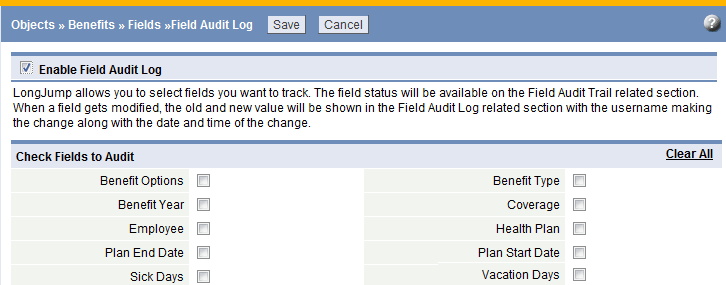Difference between revisions of "Field Audit Log Settings"
From LongJump Support Wiki
imported>Aeric m (Text replace - 'Data & Presentation > Objects' to 'Data > Objects') |
imported>Aeric |
||
| (13 intermediate revisions by the same user not shown) | |||
| Line 1: | Line 1: | ||
'''Designer | '''Designer > Objects > {object} > [Field Audit Log Settings]''' | ||
When the Field Audit Log option is enabled, any changes to the selected fields are logged in the [[Related Information]] section of the object. | When the Field Audit Log option is enabled, any changes to the selected fields are logged in the [[Related Information]] section of the object. | ||
When a field is modified, a new row containing the following information is added to the log: | When a field is modified, a new row containing the following information is added to the log: | ||
*Original field value | :*Original field value | ||
*New field value | :*New field value | ||
*User name | :*User name | ||
*Date and Time Modified | :*Date and Time Modified | ||
:''Note: Date Created is not logged'' | :''Note: Date Created is not logged'' | ||
{{ | {{permissionRef|Customize Objects|set the Field Audit Log}} | ||
{{permissions|Manage Audit Log|view the Audit Log}} | {{permissions|Manage Audit Log|view the Audit Log}} | ||
===Enable the Field Audit Log=== | ===Enable the Field Audit Log=== | ||
#Click '''Designer | #Click '''Designer > Objects > {object}''' | ||
#Click the '''[ | #Click the '''[Field Audit Log Settings]''' button | ||
#Click '''Enable Field Audit Log'''<br>The list of object fields appears. | #Click '''Enable Field Audit Log'''<br>The list of object fields appears. | ||
#:[[Image:Fieldauditlog.gif|none|thumb]] | #:[[Image:Fieldauditlog.gif|none|thumb]] | ||
| Line 25: | Line 25: | ||
===Set Field Audit Log to be Visible in Related Information=== | ===Set Field Audit Log to be Visible in Related Information=== | ||
By default, the Field Audit Log is Hidden in the [[Form | By default, the Field Audit Log is Hidden in the [[Form]]. To make it appear: | ||
#Navigate to the object of interest in [[ | #Navigate to the object of interest in [[Forms]] | ||
#Click the Display Settings link | #Click the Display Settings link | ||
#:[[ | #:[[File:Formlayouts-DisplaySettings.gif|none]] | ||
#Move the Field Audit Log object to the Visible column and Save your changes | #Move the Field Audit Log object to the Visible column and Save your changes | ||
#:[[File:displaysettings.gif|none]] | |||
#::{{:Select Multiple Values in a Picklist}} | #::{{:Select Multiple Values in a Picklist}} | ||
Latest revision as of 03:37, 22 February 2014
Designer > Objects > {object} > [Field Audit Log Settings]
When the Field Audit Log option is enabled, any changes to the selected fields are logged in the Related Information section of the object.
When a field is modified, a new row containing the following information is added to the log:
- Original field value
- New field value
- User name
- Date and Time Modified
- Note: Date Created is not logged
Users that have the Customize Objects permission can set the Field Audit Log
Users that have the Manage Audit Log permission can view the Audit Log
Enable the Field Audit Log
- Click Designer > Objects > {object}
- Click the [Field Audit Log Settings] button
- Click Enable Field Audit Log
The list of object fields appears. - Click the checkbox next to the field(s) that should be audited; Choose up to 20 fields per object
- Click [Save]
Set Field Audit Log to be Visible in Related Information
By default, the Field Audit Log is Hidden in the Form. To make it appear:
- Navigate to the object of interest in Forms
- Click the Display Settings link
- Move the Field Audit Log object to the Visible column and Save your changes
-
- To select multiple elements from a list that are not adjacent, press and hold the CTRL key and click each element individually (CTRL-click)
- To select a series of adjacent elements, click an element at the beginning of a series, press and hold the SHIFT key, then click the last element in the series (SHIFT-click)



